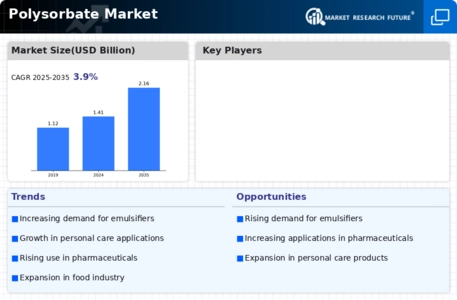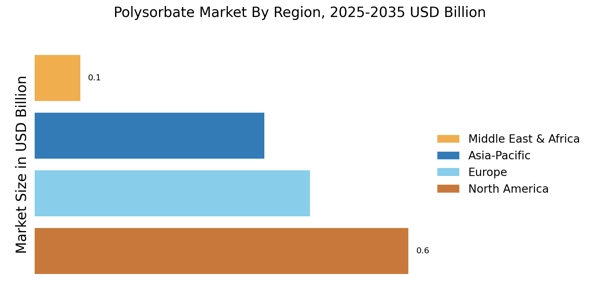Growth in Pharmaceutical Applications
The pharmaceutical sector represents a critical driver for the Polysorbate Market, as these compounds are integral to drug formulation and delivery systems. Polysorbates are utilized as solubilizers, stabilizers, and emulsifiers in various pharmaceutical products, including injectables and oral medications. The Polysorbate Market is anticipated to exceed USD 1.5 trillion by 2025, with polysorbates playing a pivotal role in enhancing drug bioavailability and stability. Furthermore, the increasing prevalence of chronic diseases necessitates the development of innovative drug formulations, thereby propelling the demand for polysorbates. As pharmaceutical companies continue to invest in research and development, the reliance on polysorbates is likely to intensify, further solidifying their importance within the Polysorbate Market.
Rising Demand in Food and Beverage Sector
The Polysorbate Market experiences a notable surge in demand driven by the food and beverage sector. As consumers increasingly seek products that enhance texture and stability, polysorbates serve as effective emulsifiers and stabilizers. The market for food emulsifiers is projected to reach approximately USD 5 billion by 2026, indicating a robust growth trajectory. This trend is further fueled by the rising popularity of processed and convenience foods, which often require polysorbates to maintain quality and shelf life. Additionally, the clean label movement encourages manufacturers to utilize polysorbates derived from natural sources, thereby aligning with consumer preferences for transparency. Consequently, the food and beverage sector's expansion significantly contributes to the overall growth of the Polysorbate Market.
Expansion of Personal Care and Cosmetics Sector
The personal care and cosmetics sector significantly influences the Polysorbate Market, as these compounds are widely used in formulations for skin care, hair care, and makeup products. Polysorbates function as emulsifiers, surfactants, and stabilizers, enhancing the texture and performance of cosmetic formulations. The Polysorbate Market is projected to reach USD 800 billion by 2025, with a growing emphasis on multifunctional ingredients that cater to diverse consumer needs. Additionally, the trend towards natural and organic products has prompted manufacturers to explore polysorbates derived from renewable sources, aligning with consumer preferences for sustainability. This expansion within the personal care sector is expected to drive the demand for polysorbates, thereby contributing to the overall growth of the Polysorbate Market.
Increasing Regulatory Support for Safe Ingredients
The Polysorbate Market benefits from increasing regulatory support aimed at ensuring the safety and efficacy of food, pharmaceutical, and cosmetic products. Regulatory bodies are establishing guidelines that promote the use of safe and effective emulsifiers, including polysorbates, which are recognized for their safety profiles. This regulatory environment encourages manufacturers to incorporate polysorbates into their formulations, thereby enhancing product quality and consumer trust. As regulations evolve, companies that prioritize compliance and transparency are likely to gain a competitive edge in the market. Moreover, the emphasis on safety and quality assurance is expected to drive innovation and research in the development of new polysorbate formulations, further propelling the growth of the Polysorbate Market.
Technological Advancements in Production Processes
Technological advancements in the production processes of polysorbates are poised to enhance the efficiency and sustainability of the Polysorbate Market. Innovations in manufacturing techniques, such as enzymatic processes and green chemistry approaches, are likely to reduce production costs and environmental impact. These advancements may also lead to the development of new polysorbate variants with improved performance characteristics, catering to the evolving needs of various industries. As sustainability becomes a focal point for manufacturers, the adoption of eco-friendly production methods could attract investment and drive growth within the Polysorbate Market. Furthermore, the integration of automation and digital technologies in production facilities may streamline operations, resulting in higher output and better quality control.


















Leave a Comment